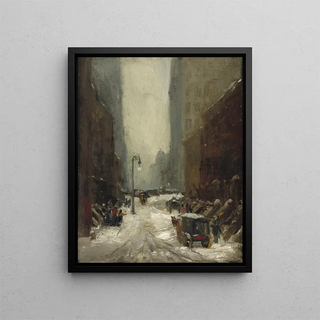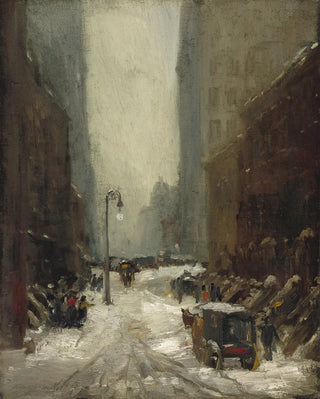Art print | Snow in New York - Robert Henri


View from behind

Frame (optional)
Reproduction Snow in New York - Robert Henri – Captivating Introduction
In the vibrant world of early 20th-century American art, the artwork "Snow in New York" by Robert Henri stands out as a true ode to urban life. Captured beneath a blanket of snow, the New York scene transforms into a lively tableau where each snowflake seems to dance to the rhythm of the city. Henri, a master of light and shadow, manages to convey the very essence of a winter day, where the cold climate contrasts with the warmth emanating from passersby. This piece, both intimate and universal, invites viewers to immerse themselves in an atmosphere filled with melancholy and beauty.
Style and uniqueness of the work
Robert Henri's style is characterized by vibrant realism, often influenced by the Ashcan School movement, of which he was a leading figure. In "Snow in New York," he employs a delicate color palette, where the bright whites of the snow blend with the dark shades of the city dwellers' clothing. The impasto technique, which adds texture to the canvas, allows viewers to almost physically feel the texture of the snow. The characters, though stylized, are imbued with great expressiveness, reflecting everyday life of New Yorkers. Henri captures fleeting moments with such intensity that they seem frozen in time, revealing the hidden beauty of ordinary moments. This artwork stands out for its ability to evoke deep emotions while celebrating the city, paying homage to its dynamism and diversity.
The artist and his influence
Robert Henri, born in 1865, is an iconic figure in American art. His commitment to depicting urban life and the working classes profoundly shaped the artistic landscape of his era. Influenced by European artists such as Velázquez and Manet, Henri developed a style that is uniquely his own, combining realism and impressionism. By founding the Ashcan School movement, he paved the way for a new vision of art, where everyday life and street scenes become subjects of interest. His influence extends beyond his time, inspiring many

Matte finish

View from behind

Frame (optional)
Reproduction Snow in New York - Robert Henri – Captivating Introduction
In the vibrant world of early 20th-century American art, the artwork "Snow in New York" by Robert Henri stands out as a true ode to urban life. Captured beneath a blanket of snow, the New York scene transforms into a lively tableau where each snowflake seems to dance to the rhythm of the city. Henri, a master of light and shadow, manages to convey the very essence of a winter day, where the cold climate contrasts with the warmth emanating from passersby. This piece, both intimate and universal, invites viewers to immerse themselves in an atmosphere filled with melancholy and beauty.
Style and uniqueness of the work
Robert Henri's style is characterized by vibrant realism, often influenced by the Ashcan School movement, of which he was a leading figure. In "Snow in New York," he employs a delicate color palette, where the bright whites of the snow blend with the dark shades of the city dwellers' clothing. The impasto technique, which adds texture to the canvas, allows viewers to almost physically feel the texture of the snow. The characters, though stylized, are imbued with great expressiveness, reflecting everyday life of New Yorkers. Henri captures fleeting moments with such intensity that they seem frozen in time, revealing the hidden beauty of ordinary moments. This artwork stands out for its ability to evoke deep emotions while celebrating the city, paying homage to its dynamism and diversity.
The artist and his influence
Robert Henri, born in 1865, is an iconic figure in American art. His commitment to depicting urban life and the working classes profoundly shaped the artistic landscape of his era. Influenced by European artists such as Velázquez and Manet, Henri developed a style that is uniquely his own, combining realism and impressionism. By founding the Ashcan School movement, he paved the way for a new vision of art, where everyday life and street scenes become subjects of interest. His influence extends beyond his time, inspiring many






